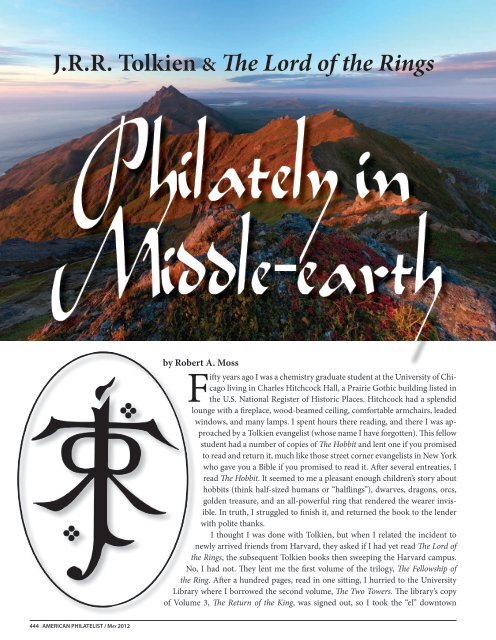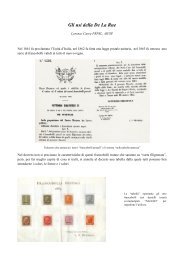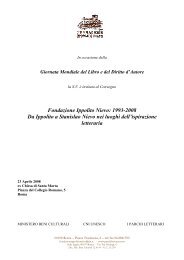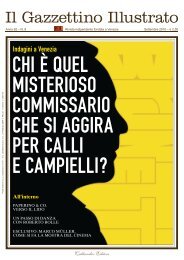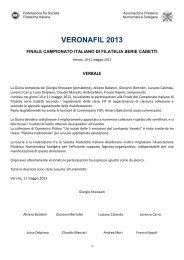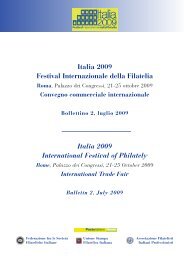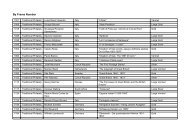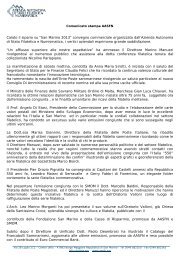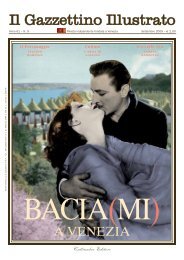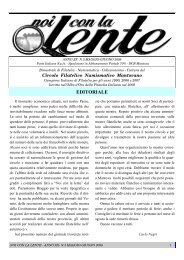J.R.R. Tolkien & The Lord of the Rings - American Philatelic Society
J.R.R. Tolkien & The Lord of the Rings - American Philatelic Society
J.R.R. Tolkien & The Lord of the Rings - American Philatelic Society
Create successful ePaper yourself
Turn your PDF publications into a flip-book with our unique Google optimized e-Paper software.
J.R.R. <strong>Tolkien</strong> & <strong>The</strong> <strong>Lord</strong> <strong>of</strong> <strong>the</strong> <strong>Rings</strong><br />
by Robert A. Moss<br />
Fifty years ago I was a chemistry graduate student at <strong>the</strong> University <strong>of</strong> Chicago<br />
living in Charles Hitchcock Hall, a Prairie Gothic building listed in<br />
<strong>the</strong> U.S. National Register <strong>of</strong> Historic Places. Hitchcock had a splendid<br />
lounge with a fireplace, wood-beamed ceiling, comfortable armchairs, leaded<br />
windows, and many lamps. I spent hours <strong>the</strong>re reading, and <strong>the</strong>re I was approached<br />
by a <strong>Tolkien</strong> evangelist (whose name I have forgotten). This fellow<br />
student had a number <strong>of</strong> copies <strong>of</strong> <strong>The</strong> Hobbit and lent one if you promised<br />
to read and return it, much like those street corner evangelists in New York<br />
who gave you a Bible if you promised to read it. After several entreaties, I<br />
read <strong>The</strong> Hobbit. It seemed to me a pleasant enough children’s story about<br />
hobbits (think half-sized humans or “halflings”), dwarves, dragons, orcs,<br />
golden treasure, and an all-powerful ring that rendered <strong>the</strong> wearer invisible.<br />
In truth, I struggled to finish it, and returned <strong>the</strong> book to <strong>the</strong> lender<br />
with polite thanks.<br />
I thought I was done with <strong>Tolkien</strong>, but when I related <strong>the</strong> incident to<br />
newly arrived friends from Harvard, <strong>the</strong>y asked if I had yet read <strong>The</strong> <strong>Lord</strong> <strong>of</strong><br />
<strong>the</strong> <strong>Rings</strong>, <strong>the</strong> subsequent <strong>Tolkien</strong> books <strong>the</strong>n sweeping <strong>the</strong> Harvard campus.<br />
No, I had not. <strong>The</strong>y lent me <strong>the</strong> first volume <strong>of</strong> <strong>the</strong> trilogy, <strong>The</strong> Fellowship <strong>of</strong><br />
<strong>the</strong> Ring. After a hundred pages, read in one sitting, I hurried to <strong>the</strong> University<br />
Library where I borrowed <strong>the</strong> second volume, <strong>The</strong> Two Towers. <strong>The</strong> library’s copy<br />
<strong>of</strong> Volume 3, <strong>The</strong> Return <strong>of</strong> <strong>the</strong> King, was signed out, so I took <strong>the</strong> “el” downtown<br />
444 <strong>American</strong> Philatelist / May 2012
to Brentano’s where I bought my own copy. I subsequently<br />
returned for <strong>the</strong> o<strong>the</strong>r volumes, too. I<br />
still have <strong>the</strong>m; <strong>the</strong> notation on <strong>the</strong>ir flyleafs reads<br />
“Chicago, October 1962.”<br />
Who was J.R.R. <strong>Tolkien</strong>, and how did he come<br />
to write <strong>The</strong> <strong>Lord</strong> <strong>of</strong> <strong>the</strong> <strong>Rings</strong> John Ronald Reuel<br />
<strong>Tolkien</strong> was born in 1892 in Bloemfontein, South<br />
Africa, <strong>the</strong> child <strong>of</strong> overseas English parents, but he<br />
and his younger bro<strong>the</strong>r, Hilary, returned to England<br />
permanently when <strong>the</strong>ir fa<strong>the</strong>r died in 1896.<br />
<strong>Tolkien</strong> was raised by his mo<strong>the</strong>r, Mabel, in Birmingham<br />
and in <strong>the</strong> nearby village <strong>of</strong> Sarehole. In<br />
1900 Mabel and her children joined <strong>the</strong> Catholic<br />
Church and Catholicism became a central feature<br />
<strong>of</strong> <strong>the</strong> mature <strong>Tolkien</strong>’s world-view. Mabel <strong>Tolkien</strong><br />
died <strong>of</strong> diabetes in 1904, after which Fa<strong>the</strong>r Francis<br />
Murphy became Ronald and Hilary’s guardian.<br />
<strong>Tolkien</strong> was educated at St. Edward’s School<br />
in Birmingham and at Exeter College, Oxford. He<br />
manifested a remarkable gift for languages, learning<br />
Greek, Latin, Gothic, Welsh, and Finnish, as<br />
well as various old forms <strong>of</strong> German and English.<br />
Indeed, as a hobby, he began to create his own<br />
languages, from which his mythology and stories<br />
later grew. It was during his Oxford studies <strong>of</strong> Old<br />
English and Old Norse that he encountered <strong>the</strong><br />
line “Hail Earendel brightest <strong>of</strong> angels, over Middle<br />
Earth sent unto men.” From this seed, <strong>The</strong> <strong>Lord</strong> <strong>of</strong> <strong>the</strong> <strong>Rings</strong><br />
(LOTR), <strong>the</strong> saga <strong>of</strong> <strong>Tolkien</strong>’s great imagined reality, was to<br />
germinate many years later. One <strong>of</strong> its earliest manifestations<br />
was a poem written at this time, “<strong>The</strong> Voyage <strong>of</strong> Earendel <strong>the</strong><br />
Evening Star.” It was <strong>the</strong> beginning <strong>of</strong> <strong>Tolkien</strong>’s own mythology,<br />
in which <strong>the</strong> legend <strong>of</strong> Eärendil <strong>the</strong> Mariner finds an<br />
honored place.<br />
After completing his degree in English Language and<br />
J.R.R. <strong>Tolkien</strong>.<br />
Literature (with first class honors) in 1915, <strong>Tolkien</strong> married,<br />
enlisted as a second lieutenant, and was sent to fight in<br />
France during World War I. Sickened by trench fever, he was<br />
returned to England, and spent months in military hospitals.<br />
<strong>The</strong>re he continued to work on his invented languages,<br />
Quenya and Sindarin, which would later become <strong>the</strong> languages<br />
<strong>of</strong> <strong>the</strong> elves in LOTR. By <strong>the</strong>mselves, <strong>the</strong>se languages,<br />
related to Finnish and Welsh, were unanchored, unassociated<br />
with <strong>the</strong>ir speakers or <strong>the</strong>ir poetry (which <strong>Tolkien</strong> also<br />
First day cover <strong>of</strong> “Magical<br />
Worlds, classic fantasy<br />
books for children” (Great<br />
Britain,1998). <strong>The</strong> 20p<br />
value (Scott 1820) honors<br />
<strong>Tolkien</strong>’s <strong>The</strong> Hobbit.<br />
May 2012 / <strong>American</strong> Philatelist 445
composed), and so <strong>Tolkien</strong> began to create a mythology as a<br />
back-story for <strong>the</strong> languages.<br />
<strong>The</strong>se early efforts led to <strong>the</strong> Book <strong>of</strong> Lost Tales, and related<br />
stories later collected in <strong>the</strong> Silmarillion. Nei<strong>the</strong>r <strong>of</strong> <strong>the</strong>se<br />
books was published during his lifetime, but <strong>the</strong>ir contents<br />
served as <strong>the</strong> background for LOTR. Indeed, one <strong>of</strong> <strong>the</strong> hallmarks<br />
<strong>of</strong> LOTR is <strong>the</strong> feeling that it imparts <strong>of</strong> great depth,<br />
<strong>of</strong> a history that narrates merely a portion <strong>of</strong> a much larger<br />
body <strong>of</strong> related lore. <strong>The</strong> reader<br />
forms that impression because it<br />
is true — an intricate tapestry <strong>of</strong><br />
interwoven mythology and languages<br />
underlies LOTR. When<br />
<strong>Tolkien</strong> came to write his epic,<br />
that imaginative world was already<br />
in place to be drawn upon.<br />
In 1918 <strong>Tolkien</strong> began working<br />
at <strong>the</strong> Oxford English Dictionary,<br />
where he honed his philological<br />
skills on words beginning<br />
with W. In 1920 he was appointed<br />
Great Britain, Scott 1820.<br />
Reader in English Language at<br />
<strong>the</strong> University <strong>of</strong> Leeds, beginning<br />
his academic career. He was to remain at Leeds for five<br />
years, during which time his intellectual life proceeded on<br />
two tracks: pr<strong>of</strong>essional literary work, exemplified by a wellregarded<br />
new edition <strong>of</strong> Sir Gawain and <strong>the</strong> Green Knight<br />
(with E.V. Gordon), and <strong>the</strong> continuing development <strong>of</strong> his<br />
mythology in <strong>The</strong> Book <strong>of</strong> Lost Tales.<br />
In 1925 <strong>Tolkien</strong> returned to Oxford as Pr<strong>of</strong>essor <strong>of</strong><br />
Anglo-Saxon, and continued <strong>the</strong>se parallel creative paths.<br />
His academic endeavors saw <strong>the</strong> publication <strong>of</strong> <strong>the</strong> highly<br />
influential lecture “Beowulf, <strong>the</strong> Monsters and <strong>the</strong> Critics.”<br />
His mythology and languages now focused on <strong>the</strong> interconnected<br />
collection <strong>of</strong> tales and legends that would ultimately<br />
be edited and published in 1977 as <strong>The</strong> Silmarillion by his<br />
son, Christopher <strong>Tolkien</strong>. <strong>The</strong> Silmarillion contains <strong>Tolkien</strong>’s<br />
creation myth, including an account <strong>of</strong> <strong>the</strong> fall <strong>of</strong> an angelic<br />
being, Melchor, as <strong>the</strong> origin <strong>of</strong> evil. Also described is <strong>the</strong><br />
creation <strong>of</strong> “Middle-earth,” <strong>the</strong> coming <strong>of</strong> elves and men into<br />
that region <strong>of</strong> <strong>the</strong> world, and an account <strong>of</strong> <strong>the</strong> forging <strong>of</strong> <strong>the</strong><br />
rings <strong>of</strong> power and <strong>the</strong> wars related to <strong>the</strong>m. Here, too, is a<br />
recasting <strong>of</strong> <strong>the</strong> Atlantis legend in <strong>the</strong> sinking <strong>of</strong> Numenor<br />
and <strong>the</strong> ruin <strong>of</strong> an ancient, noble culture <strong>of</strong> humankind. A<br />
high point is <strong>the</strong> story <strong>of</strong> Beren and Lúthien, which tells <strong>of</strong><br />
<strong>the</strong> love <strong>of</strong> a mortal man for an elf maiden. <strong>Tolkien</strong> said that<br />
his wife, Edith, “was and knew she was my Lúthien.” <strong>The</strong><br />
names “Beren” and “Lúthien” are engraved on <strong>the</strong> tombstone<br />
that J.R.R. and Edith <strong>Tolkien</strong> share in a cemetery on <strong>the</strong> outskirts<br />
<strong>of</strong> Oxford.<br />
<strong>The</strong> Silmarillion was ultimately <strong>the</strong> origin <strong>of</strong> LOTR, but<br />
an intermediate step was <strong>The</strong> Hobbit. Legend recounts that<br />
in <strong>the</strong> early 1930s, while grading examinations, <strong>Tolkien</strong> used<br />
an empty page <strong>of</strong> an examination booklet to write <strong>the</strong> cryptic<br />
sentence: “In a hole in <strong>the</strong> ground <strong>the</strong>re lived a hobbit.” By<br />
1936 he had nearly completed <strong>the</strong> story <strong>of</strong> <strong>the</strong> hobbit, Bilbo<br />
Baggins, and his quest to help a band <strong>of</strong> dwarves recover a<br />
golden hoard taken from <strong>the</strong>m by <strong>the</strong> dragon Smaug. <strong>The</strong><br />
story grew in part as bedtime readings to his four children,<br />
but an incomplete manuscript was brought to <strong>the</strong> attention<br />
<strong>of</strong> Stanley Unwin <strong>of</strong> <strong>the</strong> publishers George Allen & Unwin.<br />
Unwin asked his ten-year-old<br />
son, Rayner, to read it; Rayner approved<br />
and Unwin asked <strong>Tolkien</strong><br />
to finish <strong>the</strong> tale for publication.<br />
<strong>The</strong> Hobbit was published in 1937<br />
to critical acclaim; it has not been<br />
out <strong>of</strong> print since, and is now recognized<br />
as a staple <strong>of</strong> children’s<br />
literature.<br />
In 1998 Great Britain issued<br />
a set <strong>of</strong> five stamps to celebrate<br />
“Magical Worlds, classic fantasy<br />
books for children.” <strong>The</strong> 20p value<br />
(Scott 1820), picturing <strong>the</strong> confrontation<br />
<strong>of</strong> Bilbo and Smaug,<br />
is devoted to <strong>Tolkien</strong>’s <strong>The</strong> Hobbit. O<strong>the</strong>r stamps in <strong>the</strong> set<br />
represent <strong>The</strong> Lion, <strong>the</strong> Witch, and <strong>the</strong> Wardrobe (C.S. Lewis),<br />
<strong>The</strong> Phoenix and <strong>the</strong> Carpet (E. Nesbit), <strong>The</strong> Borrowers (Mary<br />
Norton), and Through <strong>the</strong> Looking Glass (Lewis Carroll).<br />
<strong>The</strong> success <strong>of</strong> <strong>The</strong> Hobbit led Unwin to request a sequel.<br />
<strong>Tolkien</strong> responded by submitting portions <strong>of</strong> <strong>The</strong> Silmarillion,<br />
but Unwin’s reader had mixed reactions and <strong>the</strong><br />
decision went against publication: <strong>the</strong> public wanted more<br />
hobbits, was Unwin’s advice to <strong>Tolkien</strong>. In response, <strong>Tolkien</strong><br />
began <strong>the</strong> “New Hobbit,” initially conceived as a sequel in<br />
which Bilbo’s nephew, Frodo, embarks on his own adventure.<br />
However, <strong>the</strong> tale darkened, deepened, and acquired its<br />
own momentum as <strong>Tolkien</strong> “discovered” <strong>the</strong> true nature <strong>of</strong><br />
<strong>the</strong> magic ring that Bilbo had obtained in <strong>The</strong> Hobbit. It was,<br />
in fact, <strong>the</strong> Ruling Ring, forged in <strong>the</strong> volcanic fires <strong>of</strong> Mount<br />
Doom by <strong>the</strong> evil Sauron, a servant <strong>of</strong> Melchor. Into this ring<br />
Sauron distilled a great portion <strong>of</strong> his evil nature. How it was<br />
taken from him, how it came to be lost and Bilbo to acquire<br />
it, are dealt with in o<strong>the</strong>r installments <strong>of</strong> <strong>Tolkien</strong>’s mythology,<br />
but as he continued to write, it became apparent that <strong>the</strong><br />
new tale was less a sequel to <strong>The</strong> Hobbit than a sequel to <strong>The</strong><br />
Silmarillion, imbued with similar serious intent.<br />
<strong>Tolkien</strong> labored on <strong>the</strong> new story from 1937 through<br />
1939, in parallel with his normal academic duties. As Humphrey<br />
Carpenter relates in his biography <strong>of</strong> <strong>Tolkien</strong>, “Every<br />
aspect <strong>of</strong> <strong>the</strong> earlier work was playing a part in <strong>the</strong> new story:<br />
<strong>the</strong> mythology itself, which provided both a historical setting<br />
and a sense <strong>of</strong> depth, <strong>the</strong> elvish languages that he had<br />
developed so painstakingly and thoroughly over more than<br />
twenty-five years....”<br />
446 <strong>American</strong> Philatelist / May 2012
With <strong>the</strong> start <strong>of</strong> World War II in 1939,<br />
<strong>Tolkien</strong>’s time became more fragmented,<br />
much <strong>of</strong> it claimed by wartime instructional<br />
duties at Oxford. <strong>The</strong> tale made slow progress,<br />
but a key plot development was <strong>the</strong> formation<br />
<strong>of</strong> a Fellowship, dedicated to helping Frodo in<br />
his quest to destroy Sauron’s ring, and with it<br />
<strong>the</strong> power <strong>of</strong> evil. <strong>The</strong> Fellowship represented<br />
an alliance <strong>of</strong> hobbits, men, elves, dwarves,<br />
and Gandalf <strong>the</strong> Wizard. It is tempting to<br />
regard LOTR as an allegory <strong>of</strong> <strong>the</strong> war, with<br />
<strong>the</strong> Allies or Fellowship pitted against Sauron,<br />
representing <strong>the</strong> Axis powers. However,<br />
<strong>Tolkien</strong> denied this reading and expressed a<br />
general distaste for allegory, adding, “<strong>The</strong>re<br />
is a ‘moral,’ I suppose, in any tale worth telling.<br />
But that is not <strong>the</strong> same thing.” LOTR was<br />
eventually completed in 1949, but it would<br />
take five more years until <strong>the</strong> huge saga, divided<br />
into three volumes, each comprised <strong>of</strong> two “books,”<br />
was finally published in 1954 and 1955.<br />
<strong>The</strong> reviews were decidedly mixed; C.S. Lewis (author <strong>of</strong><br />
<strong>the</strong> Narnia series and a close friend) and W.H. Auden wrote<br />
highly favorable reviews, but Edmund Wilson, <strong>the</strong> eminent<br />
literary critic, was dismissive. Never<strong>the</strong>less, sales slowly<br />
ga<strong>the</strong>red momentum, spurred by a BBC radio version, so<br />
that <strong>the</strong> first printing <strong>of</strong> 3,500 copies <strong>of</strong> Volume 1 had to be<br />
augmented by a second printing only six weeks later. A real<br />
turning point came in 1965 when Ace Books issued an inexpensive,<br />
pirated, three-volume paperback edition in <strong>the</strong><br />
United States, which sold wildly among college students,<br />
impelling <strong>the</strong> publication <strong>of</strong> an authorized paperback edition<br />
by Ballantine Books. During 1965, 100,000 copies <strong>of</strong> <strong>the</strong><br />
Ace edition were sold and <strong>the</strong>n a million copies <strong>of</strong> <strong>the</strong> Ballantine<br />
version; sales became exponential. <strong>The</strong> extraordinary<br />
popularity <strong>of</strong> <strong>The</strong> <strong>Lord</strong> <strong>of</strong> <strong>the</strong> <strong>Rings</strong> trilogy continues today,<br />
and received a giant boost from Peter Jackson’s three-film<br />
adaptation, released in 2001–2003. On <strong>the</strong> basis <strong>of</strong> both sales<br />
and reader surveys, <strong>the</strong> trilogy is one <strong>of</strong> <strong>the</strong> most popular<br />
fictional works <strong>of</strong> <strong>the</strong> twentieth century; more than fifty million<br />
copies have been sold worldwide.<br />
What makes <strong>The</strong> <strong>Lord</strong> <strong>of</strong> <strong>the</strong> <strong>Rings</strong> so captivating It is<br />
“escape fiction” at <strong>the</strong> highest level; in C.S. Lewis’s words,<br />
“heroic romance, gorgeous, eloquent, and unashamed....”<br />
It <strong>of</strong>fers an alternative reality with a richly detailed history,<br />
a world that is at once remote yet still recognizable, where<br />
good and evil are clearly defined and good triumphs through<br />
travail and sacrifice. In <strong>the</strong> 1960s, with <strong>the</strong> Cuban missile<br />
crisis and heart-breaking political assassinations, and more<br />
generally through <strong>the</strong> decades <strong>of</strong> <strong>the</strong> Cold War, when an<br />
atomic Armageddon seemed possible or even likely, <strong>Tolkien</strong>’s<br />
world provided not only escape, but consolation. <strong>The</strong><br />
trilogy spoke directly to <strong>the</strong> ‘60s counterculture; to some,<br />
Cover <strong>of</strong> Great Britain Scott Bk157, issued in 1998 to commemorate <strong>the</strong> centenary <strong>of</strong><br />
J.R.R. <strong>Tolkien</strong>’s birth.<br />
<strong>the</strong> books were an acid trip without acid. Or, as E.E. Cummings<br />
put it, “listen: <strong>the</strong>re’s a hell <strong>of</strong> a good universe next<br />
door; let’s go.” A <strong>Tolkien</strong> “cult” arose among young people,<br />
who wore buttons that proclaimed “Frodo Lives”; <strong>Tolkien</strong><br />
societies were formed; and <strong>the</strong> books were translated into<br />
many languages. I have sets in Hebrew and Russian, gifts<br />
from my children.<br />
<strong>Tolkien</strong> passed away in 1973 at <strong>the</strong> age <strong>of</strong> eighty-one. He<br />
never completed <strong>The</strong> Silmarillion, but his son Christopher,<br />
also an Oxford don, published an edited, coherent version in<br />
1977. Christopher went on to publish Unfinished Tales (1980)<br />
and a twelve-volume History <strong>of</strong> Middle-earth (1983–1996),<br />
based on <strong>Tolkien</strong>’s extensive notes and unpublished writings.<br />
<strong>Tolkien</strong>’s achievement has since been recognized in <strong>the</strong><br />
philatelic world. In 1992 Britain issued a “Prestige” stamp<br />
booklet (Scott Bk157) honoring <strong>the</strong> centenary <strong>of</strong> <strong>Tolkien</strong>’s<br />
birth. <strong>The</strong>re are no specifically <strong>Tolkien</strong> stamps within <strong>the</strong><br />
eight-leaved booklet. Ra<strong>the</strong>r, it contains four panes <strong>of</strong> lithographed<br />
Machin heads <strong>of</strong> Queen Elizabeth II at several values;<br />
however, <strong>the</strong> stamp panes alternate with four two-sided<br />
illustrated leaves devoted to <strong>Tolkien</strong>’s life and works. An<br />
interesting quotation included in <strong>the</strong> booklet is from a letter<br />
<strong>Tolkien</strong> wrote to <strong>the</strong> publisher Milton Waldman: “I was<br />
from early days grieved by <strong>the</strong> poverty <strong>of</strong> my own beloved<br />
country: it had no stories <strong>of</strong> its own.... I had a mind to make<br />
a body <strong>of</strong> more or less connected legend ... which I could<br />
dedicate simply: to England, to my country.” <strong>Tolkien</strong>’s phrase<br />
“it had no stories <strong>of</strong> its own” is curious. Surely <strong>the</strong> medievalist<br />
pr<strong>of</strong>essor had not forgotten Chaucer, Beowulf, or <strong>the</strong><br />
legends <strong>of</strong> King Arthur and Camelot. Ra<strong>the</strong>r, he referred to<br />
mythological antecedents set in a remote pre-historic Britain.<br />
Indeed, he termed his own tales a “Legendarium,” and<br />
noted that “Middle-earth is our world.... I have (<strong>of</strong> course)<br />
placed <strong>the</strong> action in a purely imaginary (though not wholly<br />
impossible) period <strong>of</strong> antiquity, in which <strong>the</strong> shape <strong>of</strong> <strong>the</strong><br />
May 2012 / <strong>American</strong> Philatelist 447
First day cover <strong>of</strong> Britain<br />
2004 (Scott 2183–2192):<br />
block <strong>of</strong> ten stamps<br />
issued to commemorate<br />
<strong>the</strong> 50th anniversary <strong>of</strong><br />
<strong>the</strong> publication <strong>of</strong> <strong>The</strong><br />
<strong>Lord</strong> <strong>of</strong> <strong>the</strong> <strong>Rings</strong>. Note<br />
<strong>the</strong> use <strong>of</strong> J.R.R. <strong>Tolkien</strong>’s<br />
monogram in <strong>the</strong><br />
postmark.<br />
continental masses was different.” This statement, too, is included<br />
in <strong>the</strong> booklet, as are leaves devoted to an alphabet <strong>of</strong><br />
runes that he devised for <strong>the</strong> language <strong>of</strong> <strong>the</strong> dwarves.<br />
In 2004 Britain issued a se-tenant block <strong>of</strong> ten first class<br />
stamps to commemorate <strong>the</strong> fiftieth anniversary <strong>of</strong> <strong>the</strong> publication<br />
<strong>of</strong> LOTR. Nine <strong>of</strong> <strong>the</strong> stamps bear <strong>Tolkien</strong>’s own illustrations,<br />
and <strong>the</strong> tenth features a map <strong>of</strong> Middle-earth<br />
drawn by Christopher <strong>Tolkien</strong>.<br />
Descriptions <strong>of</strong> <strong>the</strong> stamps follow.<br />
Top row, left to right:<br />
1. A map <strong>of</strong> Middle-earth (detail), depicting <strong>the</strong><br />
mountains, rivers, and forests as described in <strong>the</strong><br />
three volumes <strong>of</strong> LOTR.<br />
2. <strong>The</strong> Forest <strong>of</strong> Lothlorien in spring — Lothlorien was<br />
an elven kingdom where <strong>the</strong> High-Elven Queen<br />
Galadriel lived.<br />
3. <strong>The</strong> dust-jacket <strong>of</strong> <strong>the</strong> first edition <strong>of</strong> <strong>The</strong> Fellowship <strong>of</strong><br />
<strong>the</strong> Ring, showing <strong>the</strong> ruling ring, forged by <strong>the</strong> Dark<br />
<strong>Lord</strong> Sauron. <strong>The</strong> central device is <strong>the</strong> eye <strong>of</strong> Sauron<br />
within <strong>the</strong> ring, which is surrounded by <strong>the</strong> ring’s<br />
inscription in Elvish script. Translated, it reads:<br />
“One Ring to rule <strong>the</strong>m all, One Ring to find <strong>the</strong>m,<br />
One Ring to bring <strong>the</strong>m all and in <strong>the</strong> Darkness<br />
bind <strong>the</strong>m.” It is this ring that Frodo <strong>the</strong> hobbit must<br />
bring into Mordor, Sauron’s realm, and destroy by<br />
casting it into <strong>the</strong> fires <strong>of</strong> <strong>the</strong> volcano where it was<br />
forged.<br />
4. Rivendell, <strong>the</strong> home <strong>of</strong> Elrond, Half-Elven, in <strong>the</strong><br />
foothills <strong>of</strong> <strong>the</strong> Misty Mountains, is a way station<br />
on <strong>the</strong> journey <strong>of</strong> Frodo and his companions in<br />
<strong>The</strong> Fellowship <strong>of</strong> <strong>the</strong> Ring. <strong>The</strong> name in <strong>the</strong> Elven<br />
language, Imladris, means “deep cloven valley.”<br />
5. <strong>The</strong> Hall at Bag-End in Hobbiton in <strong>the</strong> Shire, <strong>the</strong><br />
residence <strong>of</strong> Bilbo Baggins and his nephew, Frodo.<br />
Note <strong>the</strong> characteristic circular door. <strong>The</strong> name<br />
“Bag-End” derives from a local appellation for <strong>the</strong><br />
Worcestershire farm <strong>of</strong> <strong>Tolkien</strong>’s Aunt Jane. <strong>Tolkien</strong><br />
once noted that “I am in fact a hobbit in all but size.<br />
I like gardens, trees and unmechanized farmlands; I<br />
smoke a pipe and like good plain food....” <strong>The</strong> Shire<br />
is <strong>Tolkien</strong>’s idealized vision <strong>of</strong> rural England.<br />
Bottom row, left to right:<br />
6. Orthanc, <strong>the</strong> Tower <strong>of</strong> Isengard, occupied by <strong>the</strong><br />
turncoat wizard Saruman, an ally <strong>of</strong> Sauron.<br />
Originally constructed by <strong>the</strong> men <strong>of</strong> Gondor, it was<br />
one <strong>of</strong> <strong>the</strong> most impregnable fortresses <strong>of</strong> Middleearth.<br />
7. <strong>The</strong> Doors <strong>of</strong> Durin, which guard <strong>the</strong> entrance to<br />
Moria, <strong>the</strong> great underground city <strong>of</strong> <strong>the</strong> dwarves,<br />
carved from living stone. <strong>The</strong> Fellowship essays<br />
a disastrous shortcut through Moria, where <strong>the</strong><br />
wizard Gandalf is lost in combat with a fearsome<br />
Balrog, a demonic power created by Melchor long<br />
before this time. Those with a magnifying glass can<br />
read <strong>the</strong> text beneath <strong>the</strong> sketch <strong>of</strong> <strong>the</strong> door: “Here is<br />
written in <strong>the</strong> Feanorian characters according to <strong>the</strong><br />
mode <strong>of</strong> Beleriand: (translated) <strong>The</strong> Doors <strong>of</strong> Durin,<br />
<strong>Lord</strong> <strong>of</strong> Moria, Speak friend, and enter.” This text, in<br />
Elvish script, also appears across <strong>the</strong> archway, above<br />
<strong>the</strong> crown and seven stars representing <strong>the</strong> ancient<br />
Dwarf <strong>Lord</strong>s. As Gandalf finally deduces, it is only<br />
necessary to speak <strong>the</strong> Elvish word mellon (“friend”)<br />
and <strong>the</strong> doors will open.<br />
8. <strong>The</strong> Tower <strong>of</strong> Barad-Dur, <strong>the</strong> Dark Tower. It is <strong>the</strong><br />
fortress <strong>of</strong> Sauron in Mordor, “with its towers and<br />
battlements, tall as hills, founded upon a mighty<br />
448 <strong>American</strong> Philatelist / May 2012
Three miniature sheets from <strong>The</strong> Fellowship <strong>of</strong> <strong>the</strong> Ring: 40-<br />
cent Gandalf and Saruman (Scott 1750a); 90-cent Frodo<br />
and Samwise (Scott 1752a); $2 Boromir (Scott 1755a).<br />
mountain-throne above immeasurable<br />
pits....”:<br />
9. Minas Tirith, <strong>the</strong> Tower <strong>of</strong> Guard, also<br />
known as Minas Arnor, <strong>the</strong> Tower <strong>of</strong> <strong>the</strong><br />
Setting Sun. It was originally a fortified<br />
city built by men <strong>of</strong> <strong>the</strong> Kingdom<br />
<strong>of</strong> Gondor centuries before <strong>the</strong> era<br />
described in LOTR.<br />
10. Fangorn Forest, <strong>the</strong> ancient forest<br />
that stood on <strong>the</strong> eastern side <strong>of</strong> <strong>the</strong><br />
Misty Mountains and was home to <strong>the</strong><br />
ents, guardians <strong>of</strong> <strong>the</strong> trees. Tree-like<br />
<strong>the</strong>mselves, <strong>the</strong> ents, led by Treebeard,<br />
become allies <strong>of</strong> <strong>the</strong> Fellowship.<br />
A second group <strong>of</strong> LOTR stamps feature <strong>the</strong><br />
trilogy <strong>of</strong> films derived from <strong>the</strong> <strong>Tolkien</strong> novels,<br />
directed by Peter Jackson and filmed in his<br />
native New Zealand. Jackson’s project required<br />
eight years to complete; his films were released in<br />
2001, 2002, and 2003, with each film corresponding to one<br />
volume <strong>of</strong> <strong>the</strong> <strong>Tolkien</strong> trilogy. Although costing $285 million<br />
to produce, <strong>the</strong> films were a major critical and financial<br />
success, garnering seventeen Academy Awards out <strong>of</strong> thirty<br />
nominations, and grossing $2.91 billion, <strong>the</strong> sixth highestgrossing<br />
film series.<br />
New Zealand issued three sets <strong>of</strong> LOTR stamps, each<br />
set corresponding to one film, <strong>of</strong>fered simultaneously with<br />
opening <strong>of</strong> <strong>the</strong> movie. I must add that <strong>the</strong> commercial instincts<br />
<strong>of</strong> <strong>the</strong> New Zealand Post were given very free rein.<br />
For example, <strong>the</strong> “ultimate” stamp collection for <strong>The</strong> Two<br />
Towers costs NZ$299.99. It includes two sets <strong>of</strong> gummed<br />
and self-adhesive stamps, six gummed stamp sheets (each<br />
<strong>of</strong> twenty-five stamps), a stamp booklet <strong>of</strong> ten self-adhesive<br />
stamps, a set <strong>of</strong> six miniature sheets, a set <strong>of</strong> six maximum<br />
cards, two first day covers with gummed and self-adhesive<br />
stamps, a set <strong>of</strong> miniature sheet first day covers, and a Presentation<br />
Pack. Redundancy not being my goal, I will describe<br />
only <strong>the</strong> miniature sheets, corresponding to eighteen<br />
scenes, six from each <strong>of</strong> <strong>the</strong> three films. Alas, each stamp is<br />
simply a direct reproduction <strong>of</strong> a movie scene; <strong>the</strong>re is no attempt<br />
at enhanced design or creative interpretation.<br />
<strong>The</strong> Fellowship <strong>of</strong> <strong>the</strong> Ring (New Zealand, 2001, Scott<br />
1750a–1755a). <strong>The</strong> 40-cent value shows <strong>the</strong> wizards Gandalf<br />
and Saruman walking in <strong>the</strong> gardens <strong>of</strong> Isengard, Saruman’s<br />
fortress. Gandalf informs Saruman that <strong>the</strong> One Ring has<br />
been found, but he will shortly learn <strong>of</strong> Saruman’s treacherous<br />
dealings with Sauron. <strong>The</strong> 80-cent design (not shown)<br />
depicts Galadriel, <strong>the</strong> Elven Queen. Frodo <strong>of</strong>fers her <strong>the</strong> One<br />
Ring; although tempted, Galadriel refuses his <strong>of</strong>fer, knowing<br />
that <strong>the</strong> ring corrupts whoever wields it. <strong>The</strong> 90-cent<br />
value pictures Frodo, <strong>the</strong> ring-bearer, and his closest hobbit<br />
companion, Samwise Gamgee. Here <strong>the</strong>y await <strong>the</strong> arrival <strong>of</strong><br />
Gandalf at <strong>the</strong> Inn <strong>of</strong> <strong>the</strong> Prancing Pony, but Gandalf, having<br />
been detained by Saruman, will not arrive.<br />
On <strong>the</strong> $1.30 sheet (not shown), <strong>the</strong> Guardian <strong>of</strong> Rivendell<br />
keeps watch over a sleeping Frodo in <strong>the</strong> elven kingdom<br />
where <strong>the</strong> Fellowship rests on its quest. <strong>The</strong> $1.50 design<br />
(not shown) pictures Strider, <strong>the</strong> Ranger who befriends <strong>the</strong><br />
May 2012 / <strong>American</strong> Philatelist 449
Three miniature sheets from <strong>The</strong> Two Towers: 40-cent<br />
Aragorn and Lady Eowyn (Scott 1835a); $1.30 Haradrim<br />
soldiers (Scott 1838a); $2 Lady Eowyn on <strong>the</strong> steps <strong>of</strong><br />
Meduseld, <strong>the</strong> great hall <strong>of</strong> Rohan (Scott 1840a).<br />
hobbits and leads <strong>the</strong>m on <strong>the</strong>ir journey. In reality, Strider<br />
is Aragorn, heir to <strong>the</strong> throne <strong>of</strong> Gondor. <strong>The</strong> $2.00 sheet<br />
depicts Boromir, son <strong>of</strong> <strong>the</strong> Steward <strong>of</strong> Gondor. Boromir is<br />
shown blowing <strong>the</strong> ancient horn <strong>of</strong> Gondor to summon help<br />
during an attack by Saruman’s orcs in which Boromir ultimately<br />
falls.<br />
<strong>The</strong> Two Towers (New Zealand, 2002, Scott 1835a–<br />
1840a). <strong>The</strong> 40-cent stamp pictures Aragorn and Lady Eowyn,<br />
niece <strong>of</strong> King <strong>The</strong>oden <strong>of</strong> Rohan. Aragorn and some <strong>of</strong><br />
<strong>the</strong> Fellowship journey through Rohan and participate in <strong>the</strong><br />
defense <strong>of</strong> its bastion, Helm’s Deep, against <strong>the</strong> orcs <strong>of</strong> Saruman.<br />
<strong>The</strong> 80-cent design (not shown) features a mounted<br />
orc raider. <strong>The</strong> orcs are a savage cross <strong>of</strong> human and elvin<br />
stock originally bred by Melchor as soldiery for use in his<br />
wars against men and elves. Later, Sauron and Saruman<br />
breed orcs for <strong>the</strong>ir own nefarious purposes. <strong>The</strong> 90-cent<br />
sheet (not shown) pictures <strong>the</strong> wizard Gandalf, reborn after<br />
his calamitous battle with <strong>the</strong> Balrog in <strong>the</strong> Mines <strong>of</strong> Moria.<br />
Gandalf is <strong>the</strong> spiritual leader <strong>of</strong> <strong>the</strong> free peoples against <strong>the</strong><br />
dominion <strong>of</strong> Sauron.<br />
<strong>The</strong> $1.30 design depicts a group <strong>of</strong> Haradrim soldiers.<br />
<strong>The</strong> Haradrim or Southrons are a fierce warrior race who are<br />
enemies <strong>of</strong> <strong>the</strong> Kingdom <strong>of</strong> Gondor and fight against it in alliance<br />
with Sauron’s armies. <strong>The</strong> $1.50 sheet (not shown) pictures<br />
Frodo, dressed in <strong>the</strong> characteristic graygreen<br />
cloak <strong>of</strong> <strong>the</strong> wood-elves. <strong>The</strong> $2 design<br />
shows Lady Eowyn on <strong>the</strong> steps <strong>of</strong> Meduseld,<br />
<strong>the</strong> royal hall <strong>of</strong> Rohan. She is strongly attracted<br />
to Aragorn, but his affections have long been<br />
given to Arwen Evenstar, daughter <strong>of</strong> <strong>the</strong> Elven<br />
King, Elrond.<br />
<strong>The</strong> Return <strong>of</strong> <strong>the</strong> King (New Zealand, 2003,<br />
Scott 18979a–1902a). <strong>The</strong> 40-cent design pictures Legolas<br />
<strong>the</strong> elven prince, member <strong>of</strong> <strong>the</strong> Fellowship and a formidable<br />
archer. Behind him is Gimli, <strong>the</strong> dwarf, Legolas’s unlikely<br />
friend. <strong>The</strong> 80-cent value features Frodo holding al<strong>of</strong>t <strong>the</strong><br />
vial given to him by Galadriel, which illuminates <strong>the</strong> dark.<br />
<strong>The</strong> 90-cent sheet depicts <strong>the</strong> hobbits Merry and Pippin,<br />
members <strong>of</strong> <strong>the</strong> Fellowship, in <strong>the</strong> flooded ruins <strong>of</strong> Isengard.<br />
<strong>The</strong> $1.30 value illustrates Aragorn in his status as King<br />
Elessar <strong>of</strong> Gondor; <strong>the</strong> King has returned to lead many allies<br />
in a final assault on Sauron’s stronghold <strong>of</strong> Mordor. <strong>The</strong><br />
$1.50 sheet pictures Gandalf <strong>the</strong> White in <strong>the</strong> last battle before<br />
<strong>the</strong> Gates <strong>of</strong> Mordor. <strong>The</strong> $2 value shows Gollum, once<br />
a hobbit-like creature named Sméagol, but now “twisted and<br />
ravaged” by thwarted desire for <strong>the</strong> One Ring that he lost to<br />
Bilbo many years before.<br />
In 2004, a year after <strong>the</strong> release <strong>of</strong> <strong>the</strong> third film, New<br />
Zealand issued a se-tenant block <strong>of</strong> eight stamps (and a corresponding<br />
souvenir sheet) featuring <strong>the</strong> landscapes <strong>of</strong> Middle-earth.<br />
As shown here, <strong>the</strong> block consists <strong>of</strong> four vertical<br />
pairs. <strong>The</strong> upper row presents four scenes from <strong>the</strong> films,<br />
while <strong>the</strong> matching lower row shows <strong>the</strong> corresponding sites<br />
in New Zealand where <strong>the</strong> filming took place.<br />
<strong>The</strong> 45-cent pair depicts <strong>the</strong> crossing at <strong>the</strong> Ford <strong>of</strong> Bru-<br />
450 <strong>American</strong> Philatelist / May 2012
Six miniature sheets from <strong>The</strong> Return <strong>of</strong> <strong>the</strong> King: 40-cent Legolas (Scott 1897a); 80-cent Frodo (Scott 1898a); 90-cent Merry and Pippin (Scott<br />
1899a); $1.30 Aragorn as King Elessar (Scott 1900a); $1.50 Gandalf <strong>the</strong> White (Scott 1901a); $2 Gollum (Scott 1902a).<br />
inen, a crucial episode in <strong>The</strong> Fellowship <strong>of</strong> <strong>the</strong> Ring, when<br />
<strong>the</strong> elven princess Arwen summons a flood to stymie Sauron’s<br />
Black Riders as she and Frodo escape into Rivendell.<br />
<strong>The</strong> matching stamp shows <strong>the</strong> Shotover River in Skippers<br />
Canyon near Queenstown, once a major goldfield, where<br />
this episode was filmed. <strong>The</strong> 90-cent pair deals with <strong>the</strong> Fellowship’s<br />
trek to Rivendell. Legolas is seen surveying <strong>the</strong><br />
rocky approach. <strong>The</strong> paired stamp shows <strong>the</strong> outcroppings<br />
near Mt. Olympus in Kahurangi National Park on New Zealand’s<br />
South Shore.<br />
On <strong>the</strong> $1.50 pair, <strong>the</strong> Fellowship approaches <strong>the</strong> Golden<br />
Hall <strong>of</strong> King <strong>The</strong>oden <strong>of</strong> Rohan and <strong>the</strong> accompanying<br />
buildings <strong>of</strong> Edoras. Shown on <strong>the</strong> matching stamp is <strong>the</strong><br />
bare, rocky hill near Mt. Sunday in <strong>the</strong> Sou<strong>the</strong>rn New Zea-<br />
May 2012 / <strong>American</strong> Philatelist 451
Four scenes from <strong>The</strong> <strong>Lord</strong> <strong>of</strong> <strong>the</strong> <strong>Rings</strong> film trilogy and <strong>the</strong> four matching sites in New Zealand (New Zealand, 2004, Scott 1956–1963).<br />
land Alps where <strong>the</strong> complex was constructed. Building <strong>the</strong><br />
Rohan set required eleven months and subsequently has<br />
attracted many tourists. <strong>The</strong> $2 pair shows Sam and Frodo<br />
approaching Mordor, passing through Emyn Muil, a range<br />
<strong>of</strong> hills cleft by <strong>the</strong> great River Anduin. <strong>The</strong> actual location,<br />
shown on <strong>the</strong> paired stamp, is in Tangariro National Park.<br />
<strong>The</strong>re <strong>the</strong> volcanic rock and ash were used for <strong>the</strong> setting <strong>of</strong><br />
Mordor’s Mount Doom, where <strong>the</strong> One Ring was forged and<br />
where it was destroyed.<br />
Lastly, in 2003, <strong>the</strong> Isle <strong>of</strong> Man issued a set <strong>of</strong> eight stamps<br />
and a miniature sheet devoted to <strong>the</strong> film version <strong>of</strong> <strong>The</strong> Return<br />
<strong>of</strong> <strong>the</strong> King (Scott 1013–1020 and 1021). Similarly to <strong>the</strong><br />
New Zealand issues, <strong>the</strong> Isle <strong>of</strong> Man stamps depict stills from<br />
<strong>the</strong> movie featuring major characters <strong>of</strong> <strong>the</strong> saga. <strong>The</strong> values<br />
and <strong>the</strong>ir subjects include: 23-pence, Aragorn wearing<br />
<strong>the</strong> crown <strong>of</strong> Gondor; 27-pence, Gimli <strong>the</strong> Dwarf; 30-pence,<br />
Gandalf and King <strong>The</strong>oden; 38-pence, Legolas mounted<br />
on his horse; 42-pence, Gollum; 47-pence, Sam and Frodo;<br />
68-pence, Legolas shooting an arrow; and 85-pence, Aragorn<br />
riding to battle.<br />
Illustrated here is <strong>the</strong> $2 miniature sheet, which depicts<br />
<strong>the</strong> One Ring, as well as Aragorn and o<strong>the</strong>r characters from<br />
<strong>the</strong> film. <strong>Tolkien</strong>’s One Ring, with its aura <strong>of</strong> evil power, has<br />
been likened to <strong>the</strong> Ring <strong>of</strong> <strong>the</strong> Niebelungen, <strong>the</strong> focus <strong>of</strong><br />
Wagner’s great operatic tetralogy. This comparison greatly<br />
irked <strong>Tolkien</strong>, who remarked, “Both rings were round, and<br />
<strong>the</strong>re <strong>the</strong> resemblance ceased.”<br />
In <strong>the</strong> last chapter <strong>of</strong> <strong>The</strong> Return <strong>of</strong> <strong>the</strong> King, <strong>Tolkien</strong><br />
wrote “...for <strong>the</strong> Third Age was over, and <strong>the</strong> Days <strong>of</strong> <strong>the</strong> Ring<br />
were passed, and an end was come <strong>of</strong> <strong>the</strong> story and song <strong>of</strong><br />
those times.” For <strong>Tolkien</strong>, it was indeed <strong>the</strong> end <strong>of</strong> a labor <strong>of</strong><br />
many years, but it was not <strong>the</strong> end <strong>of</strong> <strong>the</strong> story and song <strong>of</strong><br />
those times. Three generations later, <strong>The</strong> <strong>Lord</strong> <strong>of</strong> <strong>the</strong> <strong>Rings</strong><br />
still casts its spell, and seems likely to remain a permanent<br />
part <strong>of</strong> <strong>the</strong> literary landscape. With a new film version <strong>of</strong> <strong>The</strong><br />
Hobbit soon to be released, we may expect continued interest<br />
in <strong>Tolkien</strong>’s mythos, and perhaps fur<strong>the</strong>r<br />
philatelic tributes as well.<br />
Miniature sheet issued in 2003 for <strong>The</strong> Return <strong>of</strong> <strong>the</strong> King, Isle <strong>of</strong> Man (Scott 1021).<br />
References<br />
Carpenter, Humphrey. J.R.R. <strong>Tolkien</strong>, A Biography (London:<br />
George Allen & Unwin Ltd., 1977).<br />
Dougham, David. “J.R.R. <strong>Tolkien</strong>: A Biographical Sketch,”<br />
<strong>The</strong> <strong>Tolkien</strong> <strong>Society</strong> at www.tolkiensociety.org/tolkien/biography.html<br />
<strong>Tolkien</strong>, J.R.R. <strong>The</strong> <strong>Lord</strong> <strong>of</strong> <strong>the</strong> <strong>Rings</strong>: <strong>The</strong> Fellowship <strong>of</strong> <strong>the</strong><br />
Ring, <strong>The</strong> Two Towers, <strong>The</strong> Return <strong>of</strong> <strong>the</strong> King (London:<br />
George Allen & Unwin Ltd., 1962).<br />
Tyler, J.E.A. <strong>The</strong> <strong>Tolkien</strong> Companion (London: Pan Books,<br />
1977).<br />
<strong>The</strong> Author<br />
Robert A. Moss is Research Pr<strong>of</strong>essor<br />
and Louis P. Hammett Pr<strong>of</strong>essor Emeritus<br />
<strong>of</strong> Chemistry at Rutgers University in New<br />
Brunswick, New Jersey. He collects British<br />
covers, Channel Islands, Israel, and <strong>the</strong> Faroe<br />
Islands.<br />
452 <strong>American</strong> Philatelist / May 2012


